Distribution
Wright's nutrush (Scleria lacustris) is a non-native sedge that has been increasing in Florida wetlands. Wright's nutrush was first recorded for Florida in 1988 by Granville "Sonny" Hall who spotted locally growing clumps up to 2 m (6 ft) tall in Jane Green Swamp, an herbaceous marsh in the Upper St. Johns River Basin. Populations were developing simultaneously in a broad arc across the south central Florida peninsula. In the ensuing years, new records were made far to the west and southwest of the initial Jane Green site. Present-day distribution of Wright's nutrush extends to most of the southern peninsula with outliers as far north as Jackson County (EDDMapS 2024).
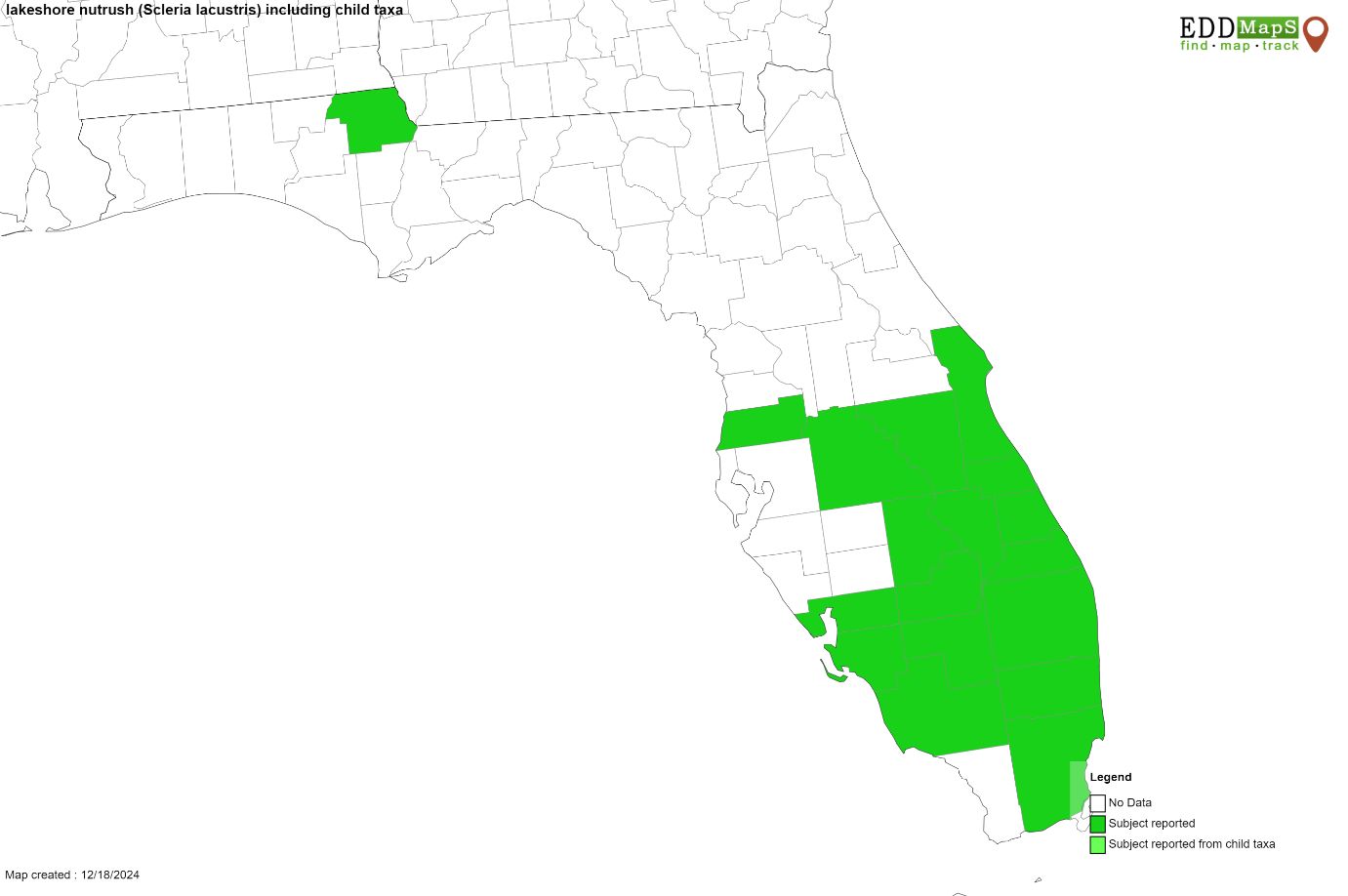
Credit: EDDMapS 2004
The native distribution of Wright's nutrush follows a trans-Atlantic pattern. It has been recorded across the lower half of the African continent, in the Greater Caribbean, and in northwestern South America. Specifically in the western hemisphere, Wright's nutrush has been collected in Cuba, Jamaica, Costa Rica, and the Atlantic regions of Guyana, Suriname, and Brazil. While this natural range is geographically wide, the actual recordings of plants have been so few that Wright's nutrush is globally regarded as an extremely rare species. That was before its establishment in Florida.
History and Impacts
Introduced populations of Wright's nutrush remained small and localized in Florida until 2001 when hundreds of acres were reported in the Blue Cypress Water Management and Conservation Areas in the Upper Basin of the St. Johns River (Figure 2). Large populations have returned to these areas every year in the past ten, except the wet years of 2005 and 2010. During 1999-2002, a period of extended drought, populations expanded dramatically in marshes of the Upper Kissimmee Basin (Figure 3), into wetlands of the Okaloacoochee Slough, and in natural areas in Lee County (Figure 4).
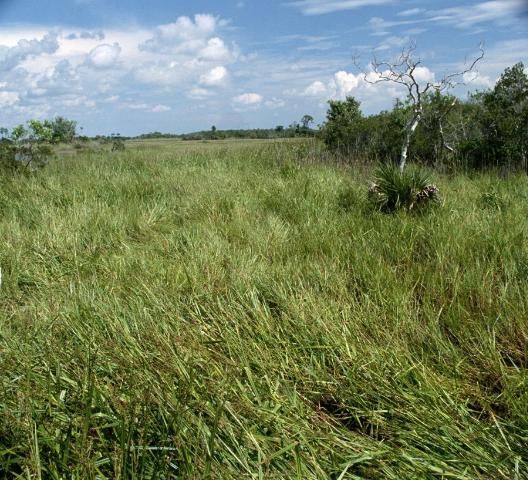
Credit: UF/IFAS
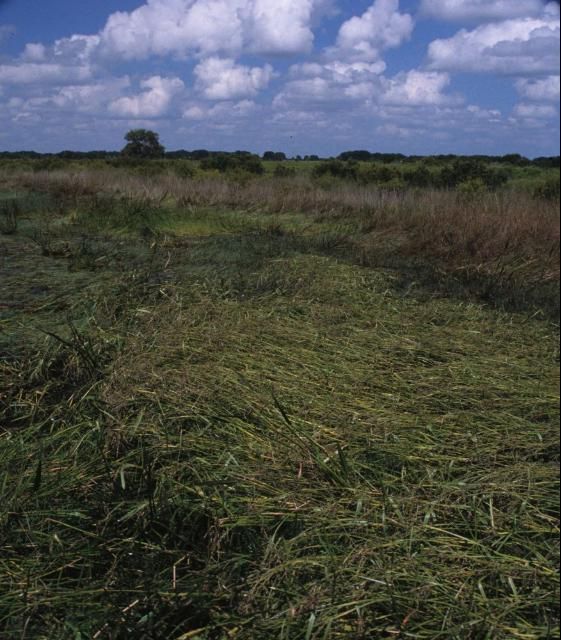
Credit: UF/IFAS
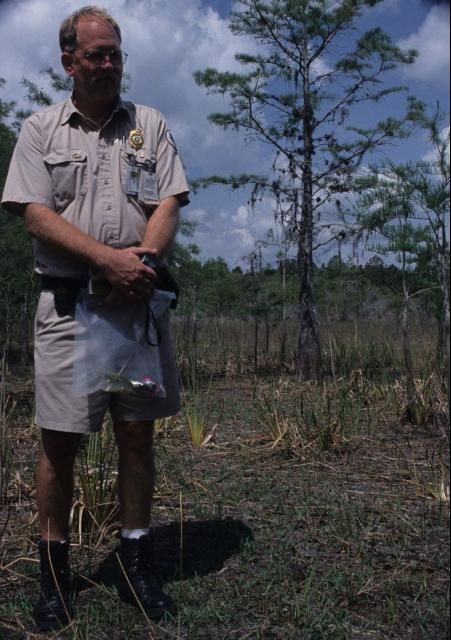
Credit: UF/IFAS
In 2005, the Florida Exotic Pest Plant Council (now named the Florida Invasive Species Council) listed Wright's nutrush as a Category II invasive exotic, consistent with its increased abundance and frequency in natural areas. Four years later, in 2009, the council raised the ranking to Category I when recognition was made of its ability to alter the composition and structure of native wetland communities. In the Blue Cypress marshes of the St. Johns River and in marshes of the upper Kissimmee River, Wright's nutrush is encroaching on empty niches, open water, and sparsely vegetated habitats that provide visual prey for wading birds and the endangered Florida snail kite (Rostramus sociabilis) (Figure 5).
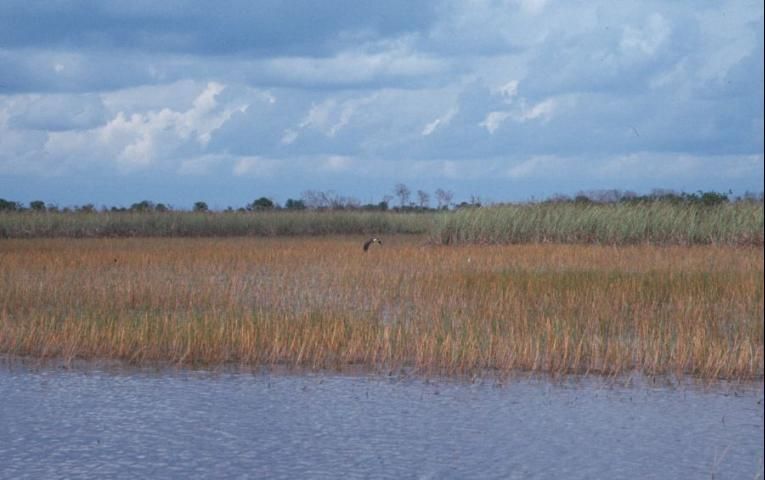
Credit: UF/IFAS
Ecological Overview
The Annual Growth Habit of an Early Colonizer
Wright's nutrush appears from seedlings that emerge early, complete their life cycle, and die within a single growing season. Wright's nutrush will not persist over winter nor will it re-grow from basal parts. Its inability to persist is unlike the dominant native species in the wetlands affected. Like other annual species, however, Wright's nutrush produces large amounts of seed that overwinter in the wetland as a source for future populations.
Sporadic Appearances and Constraints to Seedling Establishment
For many years, Wright's nutrush may be the dominant species and grow to suppress the local plant community; in other years, it may be completely absent. Such sporadic appearances are a direct result of surface water in the environment. Seedling emergence is restricted by continually saturated or flooded substrates. Constant habitats in general, whether wet or terrestrial, are not suitable for Wright's nutrush.
Seasonal Wetlands are Vulnerable to Invasion
The contrasting dry-wet extremes of Florida's seasonal wetlands offer a highly suitable environment for Wright's nutrush. Seedling emergence and seed bank viability, its most critical life history stages, are favored by the timing of surface-water fluctuations that occur naturally over the year. Dry spring seasons promote the regeneration of seedlings, and wet rainy seasons that flood the marsh in fall and winter ensure the viability of seed buried in the soil. Our field studies demonstrated a 68% rate of seedling emergence 1.5 years after seed burial in the deepest portion of a cypress pond, where water barely receded, and the soil remained wet. Where seed was buried at the higher elevation along the tree line, which was never flooded, seedling emergence was significantly less (38%). Similarly, the beneficial effect of flooded environments on seed viability in Wright's nutrush was demonstrated by a four-year study in which seed stored under constant water in an outdoor tank resulted in a 42% rate of seedling emergence compared to dry seed stored under ambient conditions that did not produce seedlings and tested as dead.
Non-forested wetlands with relatively moderate hydroperiods, those that tend to dry down every year or so for a period of several weeks to several months in late winter to spring, are vulnerable to colonization by Wright's nutrush. Graminoid, flag and saw grass marshes, maidencane depressions, Rhynchospora and Eleocharis flats, cypress strands, shallow marsh ponds, and floodplain basins all typically have hydroperiods that are moderate in duration and water depth. Long hydroperiod wetlands, such as water lily sloughs and cattail marshes, have deeper water and rarely recede for an extended period; they are typically too wet for seedlings to establish or may remain flooded so long that seeds lose viability. Short hydroperiod wetlands and more upland sites are unlikely to be invaded because they only experience shallow flooding for a short period, which makes them typically too dry in winter to maintain seeds in a viable and ready state and unable to produce a dewatered bare substrate integral to regeneration in spring.
Setting the Stage for Seedling Emergence
When spring drought induces a wetland to dry down, the stage has been set for seedlings to emerge. During water recession, the soil becomes layered in organic debris, moisture levels fall, and temperature and oxygen levels rise. These factors drive seedling emergence and establishment.
During moderately dry years, Wright's nutrush can be found as a fringe along the higher marsh elevations where water had receded in spring. Meanwhile, the deeper, continuously inundated regions will stay free of invasion. Conversely, years of extended drought and low water tables can lead to complete dryness at a pond or marsh and result in an expansive, contiguous population across a local basin.
A Persistent Seed Bank
When environmental conditions for seedling emergence are appropriate, the seed bank responds with one to several flushes of germinating seedlings over time. At the end of the emergence period, however, a portion of viable seed will still remain in the soil. This condition is described as a persistent seed bank, and it ensures a backup source for future populations.
Versatility to Hydrologic Variability During the Growing Season
Although requirements for seedling emergence are highly specific, once above ground Wright's nutrush will grow in a wide range of environments from dry to flooded sites. For example, under prolonged drought, seedling populations may have little impact on adult populations because initial seedling density was high. In contrast, a rapid influx of rainfall and flooding will stimulate upward growth in young Wright's nutrush plants. In controlled tanks, juvenile plants that were 33 cm (13.2 in) tall could grow 2.5 to 3.8 cm (1 to 1.2 in) per day to maintain their bulk above the water surface.
The degree of flooding that young plants receive will influence their overall structure. Such changes are most noticeable when comparing populations across different wetland sites. Our research showed that stem number will adjust according to depth of surface water flooding. Early, heavy inputs of rain that create deep [>20 cm (8 in)] surface flooding will suppress basal meristems and result in tall adults with only a few stems (Figure 6). Conversely, if substrates remain dry through summer or where flooding is shallow [<4 cm (2 in)], shorter, stocky plants with as many as 15 stems can develop (Figure 7).
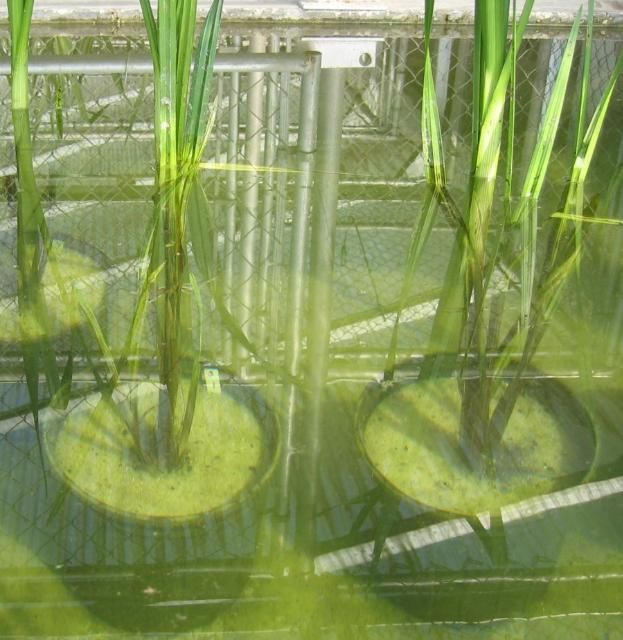
Credit: Leo Nico, USGS
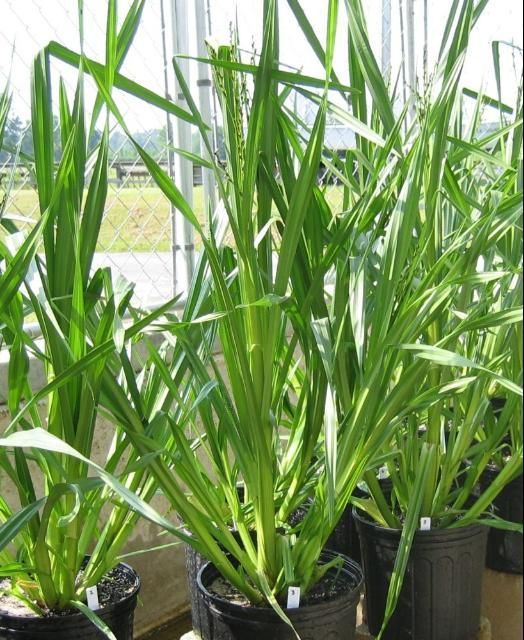
Credit: Leo Nico, USGS
Plants will produce seed whether growing in dry or flooded sites, although significantly less seed is produced from plants growing in deep water [>20 cm (8 in)]. Additionally, seed retains viability best when it falls into flooded soils that remain wet over winter. After 1.5 years of storage, losses in seed bank viability significantly correlated with the upward gradient of the marsh. When stored under the deep center of a seasonal marsh, seed had a 68% chance of emerging as seedlings. When stored at the fluctuating edge of the marsh, emergence dropped to 55%. When seed was stored above the shoreline, emergence fell significantly to 38%. Meanwhile, seed stored in an airboat garage retained only 15% chance of emergence. Thus, seed viability declined gradually as moisture levels decreased over time in a natural habitat but decreased drastically when seeds were stored away from a natural environment.
The Problem with Wright's Nutrush
Conditions associated with spring dry down are normal for Florida wetlands. In fact, intact seasonality of a hydroperiod is highly desirable for the ecosystem services it provides. A goal for many resources managers is the attainment of dry down in spring. The introduction of Wright's nutrush and the continual buildup of its seed bank in wetland substrates prone to seasonal wet/dry fluctuations present a new invasive plant management challenge.
Integrated Management
A practical goal in the long-term management of Wright's nutrush is to deplete existing seed banks and prevent re-establishment. This means preventing the onset of flowering and subsequent seed production in juvenile or immature plants (Figure 8). Managers should survey for seedlings along exposed shorelines and across basin flats as early as March and into early June or July as long as drought conditions persist. Managers should also be wary of missed flowering events and early seed maturation, as it is not unusual for plants to develop seeds as early as August.
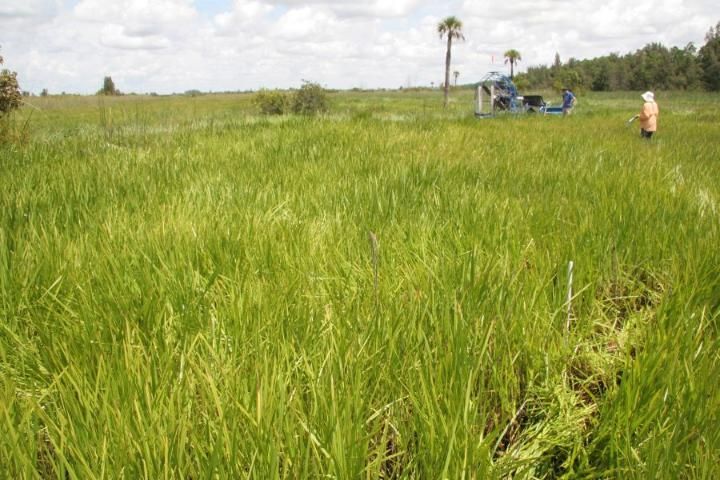
Credit: UF/IFAS
Chemical Control
We are investigating the effect of herbicide dosages and application timing for long-term control of Wright's nutrush. The aim is to minimize non-target damage to native plants by minimizing herbicide rate while preventing seed production in existing Wright's nutrush populations. Foliar-applied herbicides should be applied June through July at the juvenile stage when plants are still compact and the leaves held upright, well before flower stalks have developed. Application of a 0.05% solution of herbicide product that contains 2 lb a.i. diquat dibromide (with surfactant) to small seedlings, which should be present in June, can destroy 100% of the plants. Later application in mid-July, when plants are more developed, will require solutions of 0.1% to 0.2%. Due to the dense, overlapping growth at the later growth stage, a follow-up herbicide treatment should be completed within 14 days of the initial application to ensure that all plants within the treatment area are treated. Little permanent damage to desirable perennial plants will result from overspray of 0.05% diquat dibromide solution. Application of 0.1% to 0.2 % solution will result in only temporary damage to common herbaceous species (see Table 1).
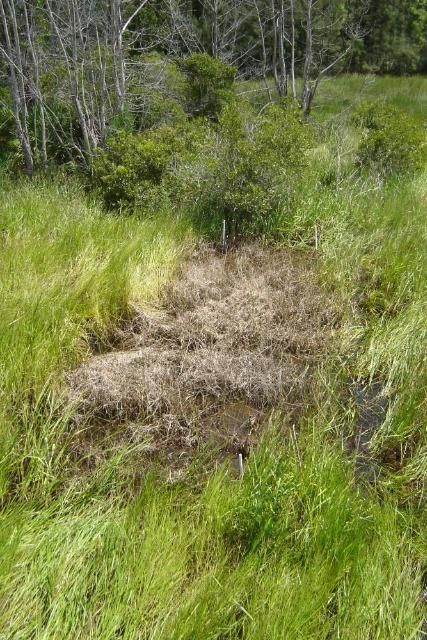
Credit: UF/IFAS
Pros and cons exist when fine-tuning decisions over the timing of herbicide application. Treating very early (when plants are only calf-high) prevents buildup of a bulky, non-native biomass (Figure 10), but marsh surfaces may still be dry, in which case ATVs will be required for site access. Even if ATVs can be used, a drawback in applying herbicide while the marsh surface remains dry is that seedling emergence can be expected to continue and thus retreatment is required later. Waiting too long (waiting for re-flooding to allow airboat access) accepts the risk of early flowering and seed set in the time delay and allows growth of large quantities of plant growth that will exclude desirable plants. Biomass produced by Wright's nutrush decays poorly in the water and contributes to muck buildup the next spring. Also, diquat will not impact seeds. If seeds are visible on the flower stalk, you have missed the chance to make an application. Even green seeds can be viable.
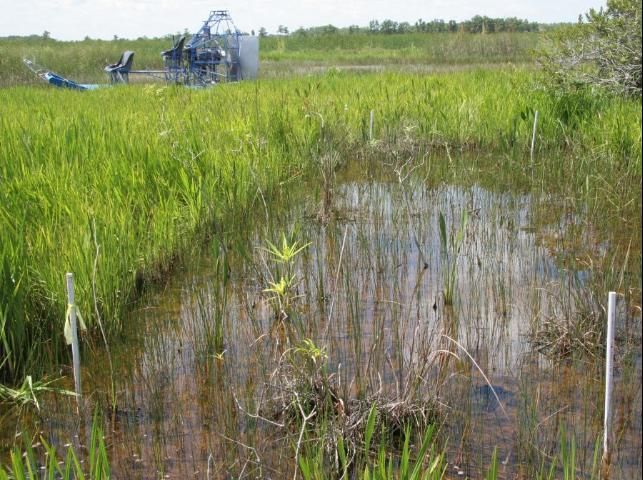
Credit: UF/IFAS
It is important to treat Wright's nutrush prior to seed production to eliminate more seeds from entering the seed bank. This is best accomplished if herbicide treatments are performed in mid-July or earlier. Monitoring and re-treatment should be conducted to control new seedlings that emerge.
Mechanical Control
Pulling up seedlings and clipping the seed heads is feasible in small, localized populations if return visits are made. Seed heads clipped from mature plants should be dropped directly into heavy bags, sealed, and land-filled. Gloves, long sleeves, and long pants should be worn to protect from the prickles.
Preventing Spread
The impervious, smooth coats of Wright's nutrush seeds ensure their passive dispersal through surface waters. Across drainage regions, however, seed is primarily transported by airboats (Figure 11). Airboats moving across wetland vegetation will shatter seed heads and become effectively contaminated in the process. A shop vacuum lined with a heavy paper bag is recommended to clean out boats.
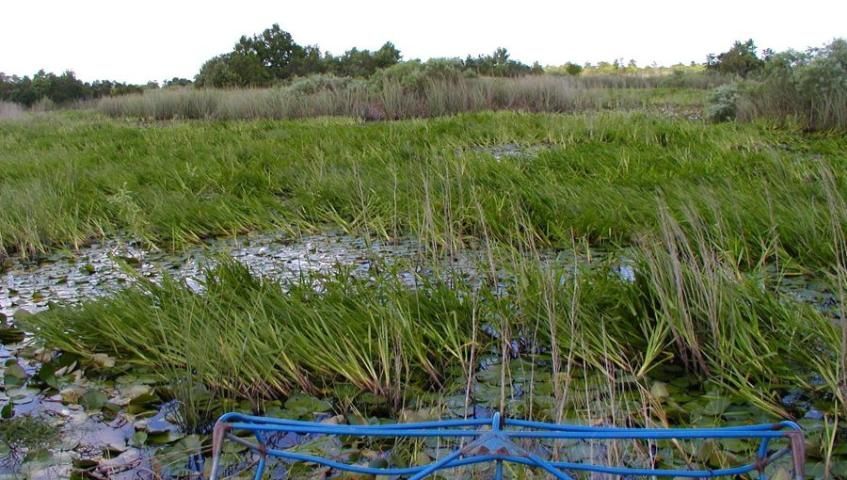
Credit: Ken Snyder
Cultural Control
In areas where water management is possible, a delay in the implementation of draw down in spring will result in a similar delay of seedling emergence. Because plants that emerge weeks to months later than normal have been shown to lag significantly behind in size and in ultimate seed production, draw down delays may be useful as part of a long-term management program.
Identification
Related Species in Florida
Florida hosts nine native species of Scleria that are readily distinguished from Wright's nutrush. Wright's nutrush is larger and grows in wetter habitats than those preferred by our native species. Native nutrush species are much smaller. Their leaves are never wider than 1 cm across, and overall plants rarely reach 1 m high. Most are clump forming and perennial.
While all native nutrush species have a tendency to grow in wetlands, two species (S. reticularis and S. verticillata) have stronger affinities to wetter habitats and could be seen near locales hosting Wright's nutrush. Yet, neither has been found associating closely with Wright's nutrush, meaning they have not been found in the same habitat during the same time as Wright's nutrush. Like Wright's nutrush, S. reticularis and S. verticillata are annuals in growth habit; they establish from seed and grow quickly to produce a few upright stems. Their similarities with Wright's nutrush stop abruptly at size. The adult height of S. reticularis and S. verticillata compares to the seedling height of Wright's nutrush. The seeds differ as well; the native species are textured, while Wright's nutrush is smooth.
Recognizing Plants as They Grow
Individual plants of Wright's nutrush typically have one to five lead stems that grow from 75 to 200 cm (29 to 79 in) tall. Stems are strongly three-sided and heftier in girth than other grass-like species occurring in Florida marshes (Figure 12). Each angled side measures 1.5 to 2.5 cm (0.59 to 1 in) across. The lower stems fill with spongy aerenchyma tissue to promote oxygen exchange and buoyancy as surface water rises in summer. When lower stems become flooded or upper stems fall across deep surface waters, small fibrous roots develop at the nodes. Vertical streaks of dark red run down the stem base and through the roots (Figure 13). Individual plants do not spread or produce runners and are easily pulled from the substrate.
![Figure 12 The strongly three-sided stems of Wright's nutrush are typical for a sedge species. The width of each side, however, is exceptionally broad [up to 2.5 cm (1.5 in) across], which makes for an extremely robust plant that is tolerant of wet as well as dry conditions during the summertime growth period.](/image/AG352/Dn99iigzn3/Idyeneje4j/Idyeneje4j-2048.webp)
Credit: UF/IFAS
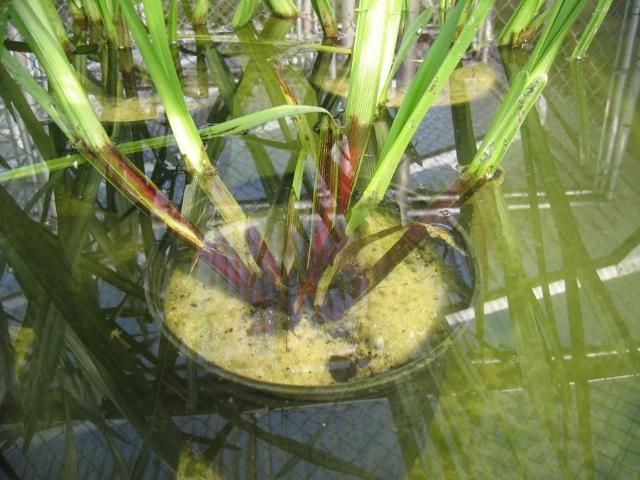
Credit: Leo Nico, USGS
Leaves grow up to 60 cm (24 in) long and 2.5 cm (1 in) wide. Linear in shape, they taper broadly to end in a blunt tip. They are known for their "W-like" pleat and reflective shine (Figure 14). Younger plants hold their leaves tightly upright; but as they grow, the stems elongate, making the leaves droop and become widely spaced. At maturity, plants appear lanky with rarely more than 6 to 8 leaves developing off a single stem.
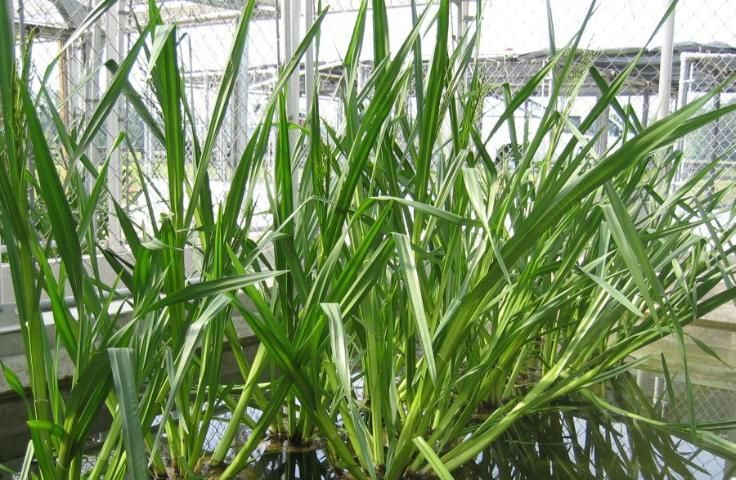
Credit: Leo Nico, USGS
Flowers are produced on rigid stalks that emerge from the top of stems (Figure 15). These stalks can grow to 30 cm (11.8 in) before they mature (Figure 16). Lacking showy petals or sepals, the flowers are often overlooked when they appear (July through August). Within weeks, however, they become more noticeable as they fill. As the seeds mature (September to October), the plants have already begun to senesce, turning a straw yellow-green from the fresh bright-green of summer. Meanwhile, the seed stalks darken, which paints a rusty hue across the tops of standing populations (Figure 17). This characteristic color scheme of rust over green is immediately recognizable to people who spot Wright's nutrush from an airboat, helicopter, or plane.
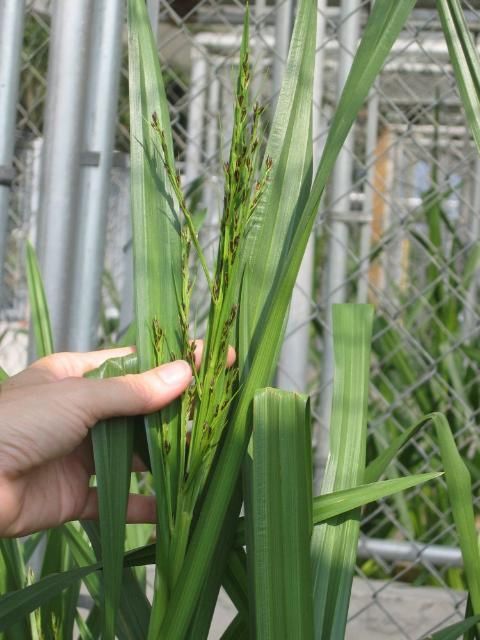
Credit: Leo Nico, USGS
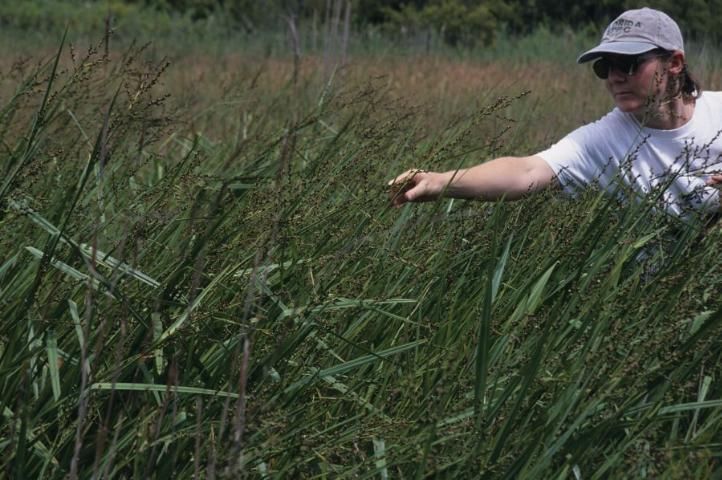
Credit: UF/IFAS
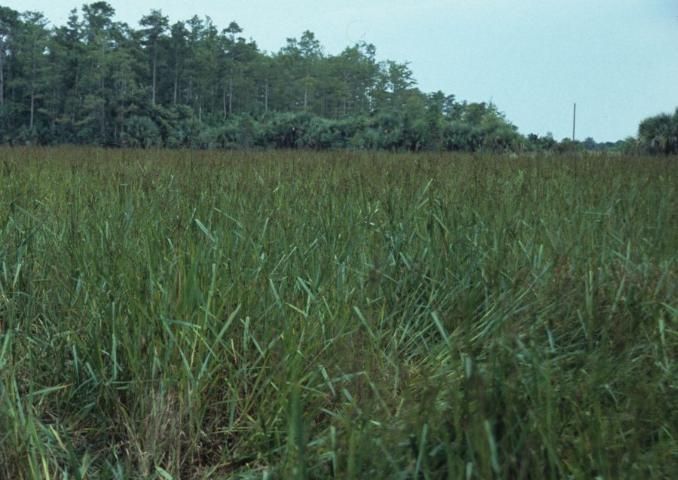
Credit: UF/IFAS
Seeds (botanically, achenes or nutlets) are oval to elliptic and softly triangular in outline, especially at the base (Figure 18). At 3.5 mm (1.4 in) long, they are larger than the seeds of native nutrush species. A shining jade-green when fresh, seeds turn mottled tones of olive-green to white when dry (Figure 19). Flowers are wind-pollinated and individual plants are self-fertile, indicating that a single plant is capable of seed production (Figure 19). Field collections yield about 300 seeds per plant and as assessed by springtime germination, seed viability is 90%.
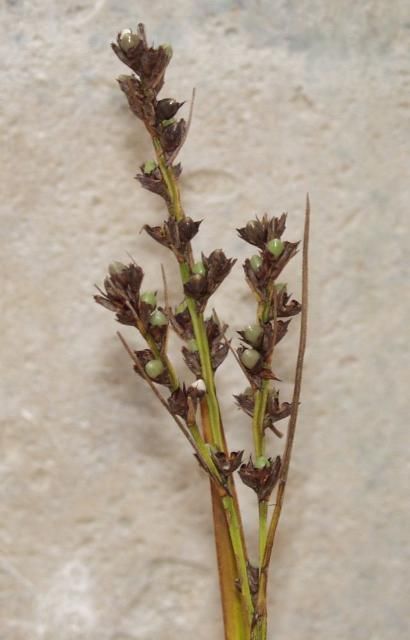
Credit: UF/IFAS
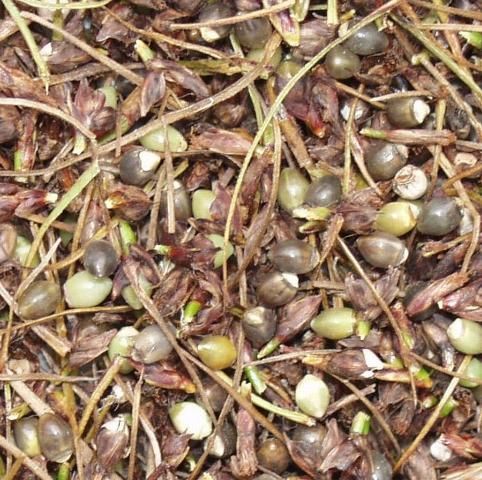
Credit: UF/IFAS
Seedlings emerge (April through June) as a single strap-like leaf that grows to 6 cm (2.4 in) before a three-angled stem develops. Seedlings can be recognized in the field by their sheathing leaf bases and roots tinged a dark red (Figure 20). The empty seed often remains attached at the junction of the primary root with the base of the stem, and because it is distinct from native nutrushes, this can give positive identification of seedlings as early as the first days of emergence.
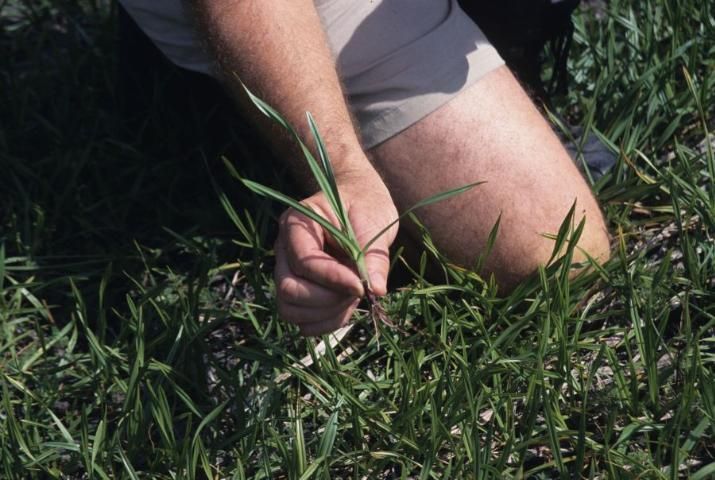
Credit: UF/IFAS
Harsh, silica-based prickles line the margins of all parts of the plant. As with sawgrass, many sedges are armed with prickles, but those on Wright's nutrush seem especially prominent (Figure 21).
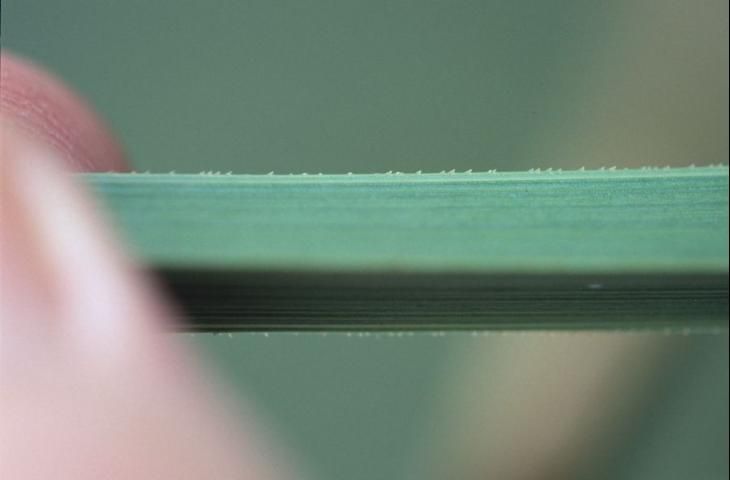
Credit: UF/IFAS
Acknowledgements
The authors thank Leo Nico, United States Geological Survey; and Ken Snyder, St. Johns Water Management District, for sharing photographs (where indicated) and for providing instructional and technical support through the entire ten-year course of study on Wright's nutrush. Alison Fox, Kaoru Kitajima, Gary Nichols, Ed Harris, David Renz, Brent Bachelder, and many others contributed to the project. Grant funding for research was provided by the Florida Fish and Wildlife Conservation Commission, the Florida Exotic Pest Plant Council, and the St. Johns Water Management District. The United States Geological Survey employed the primary author during the initial seven years of the project. Anne Taylor, Jason Ferrell, and Michael Netherland improved the manuscript with editorial review.
References
EDDMapS. 2024. Early Detection & Distribution Mapping System. The University of Georgia—Center for Invasive Species and Ecosystem Health. Available online at https://www.eddmaps.org/; last accessed December 18, 2024.
Table 1. Application of 0.1% to 0.2% solution of Reward Landscape and Aquatic Herbicide will result in only temporary damage to the following species: